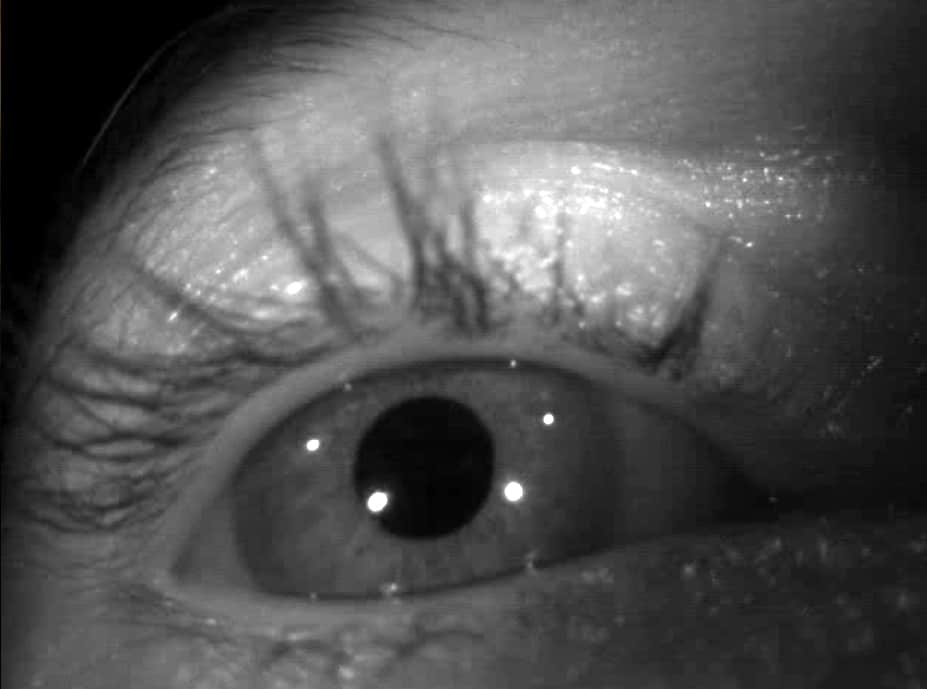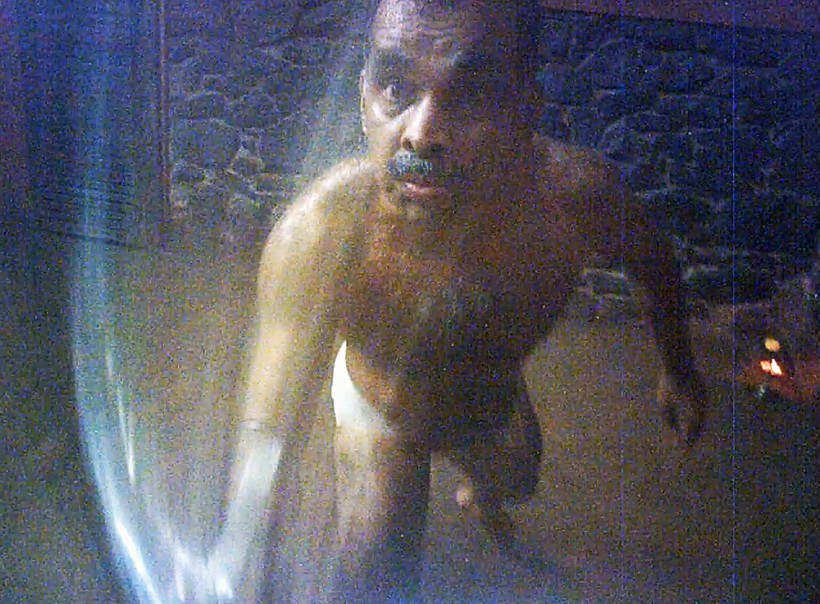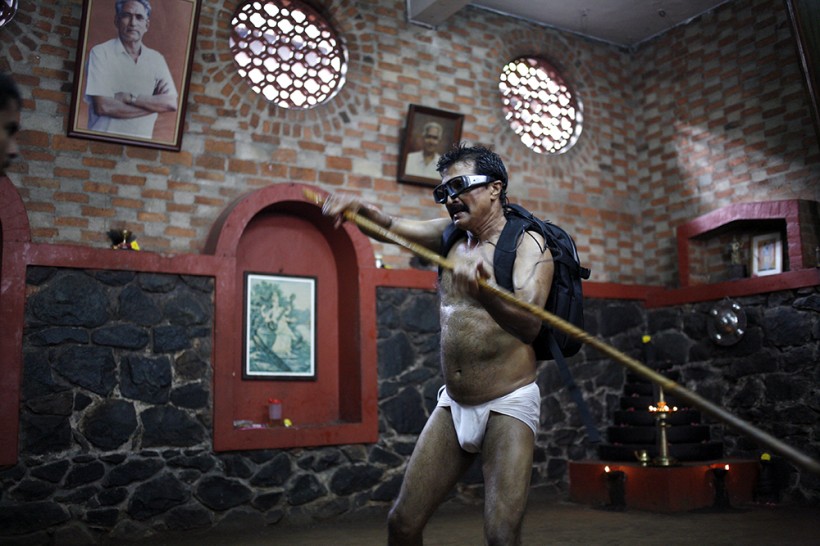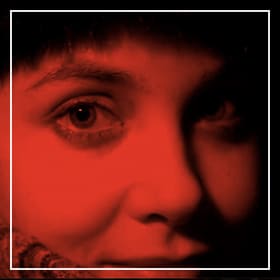Muscles have nothing to do with Kalari. It is all about the flow of energy – about the inner body.
This is how Sathyan, a Master of Kalaripayattu, describes this martial art of Kerala, South India. Masters of Kalarippayattu emphasise that a relationship exists between how a student progresses in the art and staring. When training with students “I am looking for the gaps”, says Sathyan. These moments of inattention where the student loses the intensity of his gaze are the privileged moment for the attack. The teacher even asks the student to “shut his eyes so that the opponent can read his intentions”.
The art of Kalarippayattu is believed by many to be one of the world’s oldest marshal arts, and it is a mastery of movement, and formed on a choreography based upon kicks declined in 8 figures, those being nerkal – straight leg, konkal – leg angle, puramkal – outside leg, tiruccukal – turning leg, tirumkal– step inside, vitukal – circling leg, catiparumkal – outside leg jumping, iruttikal – sitting back leg, as well as 8 postures of animals, namely lion, elephant, rooster, horse, fish, wild boar, snake and cat, and 3 sequences called coq or Elephant suites, and Surya Namaskaram,

Phillip Zarrilli has written a book called When the Body Becomes All Eyes. The title is a translation of a traditional ‘folk saying’ in Malayalam about the ideal state of awareness for the kalaripayattu practitioner. Simultaneously the book is a general commentary on an optimal state of awareness beyond references to the physical eyes per se, directing us toward the idea that the athlete’s body and her mastery over it should be guided by one’s vision of the right gestures.
According to legend, Kalarippayattu was brought to Kerala by Bodhidharma, a Buddhist monk who founded the Shaolin Monastery. Although there is no historical verification, the legend draws a link between the body-eye and fixed gaze as forming required conditions for accurate and fair action. This condition is also connected to a mystical practice of the art of war that passes through Asia. In his book, The Unfettered Mind, Takuan Soho explains further how the central vision, maintained in one single point, allows the practitioner to modify also one’s perception of time:
What is called Fudo Myoo is an immutable spirit and unwavering body. Unwavering means that holds nothing. Give a glance at something without the mind stopping there is said to be immutable wisdom. This is because the mind stops on something and that in itself different judgments arise that it becomes prisoner of various movements. When these movements cease, the mind stopping moves, but in fact does not move at all. (The Unfettered Mind, p. 25)

From a biomechanical point of view, staring gives a new point of balance to the body. Each choreographic series is measured in steps in the narrow space of the Kalari. The more a student progresses in arms, the more also the distance narrows: long sticks are replaced first by short sticks, and finally by the dagger or ottakol – a small short and sharp weapon, whose practice is limited to masters. However, the more the space between the two practitioners shrinks, the more the look intensifies.
What is happening in these moments to the perception of body movement? What can eye tracking records of this “inner body” referred by the practitioners reveal? What is the strategy of focusing martial arts? To gain more information, as part of our research we equipped Raja, Anu and Salz with eye trackers. The results are being processed at Lutin Userlab, Cité des Sciences et de l’Industrie, Paris, and the first results show that the gaze of the Master is centered and fixed. Thus, from an anthropological point of view, this gaze questions the ethnography of the body posture of the practitioner. It also queries the system of representation in regards to what constitutes vision in a Keralan logic.
While the practice of martial is often the basis for training the actor’s body, we can find the joint action of acting and martial arts throughout Asia. Mention may be made of the tradition of No, Kabuki, Kathakali or the Kutiyattam for example. In his article “Even the squirrel does what he can,” Virginia Johan describes the transmission of movement from master to student:
“Bring up the strength in your eyes, not in the neck or elsewhere.” Asan knows how to locate, identify and redirect stress points. The energy has to go into his eyes. According to the saying that based on acting, eyes always follow the hands:
Where the hand goes, follow the look, where the look goes will follow the mind, where the mind goes follows the emotion (or state), where the emotion is going the rasa (aesthetic emotion) comes.
In fact, the look goes beyond the hand, projecting gesture in space to infinite boundaries of the acting area. Here, Sangit eyes draw a large circle, that goes far beyond this « everything » gesture they accompany. The depth of field of view depends on the breath (svasam, prana) or “wind” (vayu), on which Asan constantly insists: “By opening the eyelids wide, your eyes will have more life. Look with force (sakti)”. Asan takes off his glasses to show the expression.” (Johan, 2011)
Kalari training requires about fifteen years, and it can take up to twenty years to become Gurukkal. During his training, the financial survival of the student must be ensured. Later, he will become an orthopedic doctor with Ayurvedic experience: a specialist of body movement, caring through oil massage.

The Nayar model once led to the emergence of many forms of theater and dance in Kerala, the transformation of the traditional system goes along with changing social, political and economic issues affecting the daily life of Malayalis. Unfortunately, it is almost impossible to find young students who will devote their entire lives to the practice of Kalarippayattu. Beyond providing testimony concerning an “endangered” practice, our work highlights the internal logical organization, work on emotions and consistency of the feet, hands and eyes.
Works Cited
BOUILLIER Véronique et TARABOUT Gilles (Dir.), 2002 : Images du Corps dans le Monde Hindou, CNRS Editions, Paris.
GRIMAUD Emmanuel, 2013 : « Capter, mesurer les mouvements oculaires » pp : 31-66, Petit précis de méthodologie, le sens du détail dans les sciences sociales, Le Bord de l’Eau, Paris.
JOHAN Virginie, 2011 : « Même l’écureuil fait ce qu’il peut » pp : 39-78, Construire les savoirs dans l’action. Apprentissages et enjeux sociaux en Asie du Sud, Purusartha n°29, EHESS, Paris.
SOHO Takuan, 2001 : L’esprit indomptable, Budo Editons, Les éditions de l’Eveil, Paris.
ZARRILLI Philipp, 1998 : When the body becomes all eyes Paradigms, Pratices, and Discourses of Power in Kalarippayattu, a South Indian Martial Art, Oxford University Press, New Delhi.






